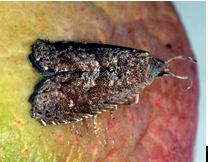Oriental Fruit Moth Predictive Model
The oriental fruit moth is pest of peaches and apples in Kentucky. This can have six generations from spring through fall. Larvae of feed on fruit, when available, but will also attack succulent terminal growth causing twig dieback.
Identification and Biology
The oriental fruit moth is a 1/4 inch (6 to 7mm), charcoal-colored, nondescript moth. Fine alternating bands of light and dark lines on the wings give it a mottled appearance. The larva is similar to codling moth, pinkish with a brown head and 1/2 inch long.

The adult Oriental fruit moth is about half the size of codling moth.
Control of Oriental fruit moth in commercial orchards relies on regular scouting of the trees and fruit, pheromone trapping, and the use of weather monitoring and degree day models. Traps should be monitored twice a week early in the season and on a weekly basis starting in mid May.
Pheromone Trapping
Pheromone trapping uses chemical lures to attract male moths. A trap consists of plastic top and bottom held together by a wire hanger with the lure placed inside (1C or 1CP trap). Traps are hung in the southeast part of the tree at eye level, usually 1 for each 10 acres (minimum of 2/orchard) in commercial orchards. Traps should be hung pre-bloom with lures replaced monthly.
Degree Day Accumulation
Initial trap catch in the early spring is termed the biofix. The biofix for Oreintal fruit moth is the date of the first sustained flight of moths. After the biofix, degree days are calculated daily and compared with the target values in the following table.
Degree day targets for the various
Oriental fruit moth insecticides